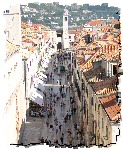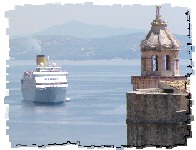|
 Founded 1300 years ago, Dubrovnik's appeal lies in the old town of Stari Grad, with its marble-paved squares, steep cobbled streets, tall houses, convents, churches, palaces, fountains and museums, all cut from the same light-coloured stone. The intact city walls keep motorists at bay, and the town has an agreeable climate and lush vegetation, due to its location at the southern end of the country's Adriatic coast. Although Dubrovnik was heavily shelled in 1991, it has been largely restored recent. Founded 1300 years ago, Dubrovnik's appeal lies in the old town of Stari Grad, with its marble-paved squares, steep cobbled streets, tall houses, convents, churches, palaces, fountains and museums, all cut from the same light-coloured stone. The intact city walls keep motorists at bay, and the town has an agreeable climate and lush vegetation, due to its location at the southern end of the country's Adriatic coast. Although Dubrovnik was heavily shelled in 1991, it has been largely restored recent.
The Stradun, Dubrovnik's wonderful pedestrian promenade, runs from the city bus stop outside
Pi le Gate to the clock tower at the other end of town. Just inside the Pile Gate, the Franciscan Monastery houses a pharmacy which has been operating since 1391. At the other end of the Stradun stands St Blaise's Church, a lovely Italian baroque building, and the Gothic Rector's Palace, built in 1441. Opposite is a bustling morning market. le Gate to the clock tower at the other end of town. Just inside the Pile Gate, the Franciscan Monastery houses a pharmacy which has been operating since 1391. At the other end of the Stradun stands St Blaise's Church, a lovely Italian baroque building, and the Gothic Rector's Palace, built in 1441. Opposite is a bustling morning market.
Dubrovnik's city walls were built between the 13th and 16th centuries, and are still intact today. Arguably the finest city walls in the world, they are over 2km (1.2mi) long and 25m (82ft) high, with 16 towers. You can't beat the view from here, and a walk along the walls will probably be the highlight of your visit to Dubrovnik.
If you feel like a spell in the sun, you could stretch out on Dubrovnik's city beaches, but a better bet is to take the 10 minute ferry ride to Lokrum Island. This island is a luxuriantly wooded nature reserve with a rocky nudist beach, a botanical garden and the remains of a Habsburg fortress..
|